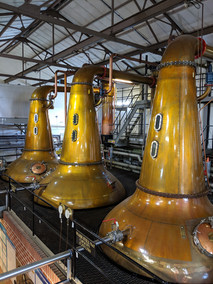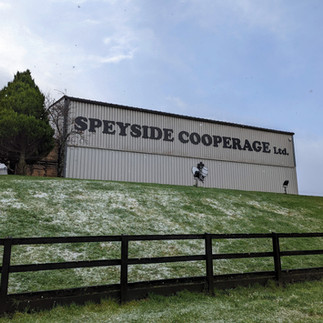Discover Your Backyard: Speyside, from Ballindalloch to Rothes
- Barry Pickard

- Sep 20, 2023
- 8 min read
Updated: Oct 11

**Disclosure: This post contains affiliate links. Regardless of this, please be advised that all opinions expressed in this blog post are genuine and authentically my own.**
Author: Barry Pickard
Hi, I'm Barry, the owner of Tailor-Made Itineraries and I have been designing bespoke self-guided tours for adventurous and curious travellers since 2015. I am a history graduate with a passion for travel.
I created this blog to show, through my own adventures, how you can have an incredible travel experience as an independent traveller, giving you the information to navigate the world with confidence.
The majestic River Spey begins life in the hills south of Newtonmore, before cutting its way north-east through stunning landscapes of the Highlands and of Moray, till reaching the coast at Spey Bay. Along the way, the river connects the two settlements of Ballindalloch and Rothes, with a host of attractions in between. This area really encapsulates all that is special about Speyside (also known as Strathspey, which is the non-anglicised name!), with amazing landscapes and hills, many of the most famous whisky distilleries in the world, as well as some fascinating historical places. This area of Speyside also has several culinary highlights, but we will have to cover that in another post – we can only cram so much into this post!
So read on and join us as we discover the delights of Speyside, from Ballindalloch to Rothes.
Don’t forget that Tailor-Made Itineraries delights in creating bespoke self-guided tours. So, if visiting Speyside appeals to you, reach out to me by email. I would be more than happy to design a self-guided tour around your requirements incorporating the attractions of Speyside, or indeed, any other part of Scotland.
Ballindalloch Castle and Gardens
The obvious starting point for the journey through this part of Speyside is the “Pearl of the North” – Ballindalloch Castle. This impressive castle has been home to the Macpherson-Grant family since 1546. You can tour part of the castle, while perusing their important collection of 17th century Spanish paintings, and you may even bump into The Green Lady, the castle’s very own ghost! There are also the beautiful gardens for you to enjoy and then you can relax with a coffee and ‘fine piece’ (cake) at the tearoom.

Ballindalloch Distillery
Soon to join the pantheon of great Speyside whiskies, the ‘water of life’ has been crafted at Ballindalloch Distillery since opening in 2015. Visits are by appointment and are available Monday to Friday. The history of distilling on the Ballindalloch Estate, however, dates to the early 1820s when a distillery was built where the nearby Delnashaugh Hotel is sited today.

Ancient History
The area around Ballindalloch is crammed full of ancient history. There are three stone circles, all over 4,000 years old! Upper Lagmore Stone Circle is sited on a hill overlooking the Ballindalloch Distillery, while the remains of Lower Lagmore Stone Circle can be seen on your left-hand side as you approach the distillery. Then there is the Marionburgh Stone Circle, which is in the grounds of Ballindalloch Castle.
Tailor-Made Top Tip: To see the Marionburgh Stone Circle, it is best to park up before the ticket booth and walk down to the small copse of trees on the left, just before the road bends to the right as it continues to the castle.
There are also the Inveravon Pictish Stones on display at the Inveravon Parish Church. These intricately carved stones were probably cut around 800AD and can be found within the shelter of the church’s north wall porch. The porch is permanently open, allowing the visitor to view these ancient carvings. The church itself is of interest. Built in 1806, it is only the latest in a series that have stood on the same site. It is possible that a chapel was built here by St Drostan in the early 600s, and the presence of Pictish stones in the immediate vicinity suggests there was significant activity here during the centuries that followed.
Tailor-Made Top Tip: Explore the cemetery and look out for the large stone mausoleum. This was built in 1829 and commemorates members of the MacPherson-Grant family, residents of nearby Ballindalloch Castle.
Not as old, but equally impressive is the Bridge of Avon. Built during the construction of the military road through Avonside in 1754, it was once the main route across the clear waters of the Avon and is now an attractive picnic site and excellent vantage point for viewing this lovely river.

If you are enjoying this post, remember and subscribe to my mailing list to receive my latest blog posts.
The Speyside Way
The Speyside Way is a long-distance path which begins in Buckie and ends at Newtonmore,137 kilometres (85 mi) away. The section of the path between Ballindalloch and Rothes is a very pleasant walk and follows the former Strathspey Railway. One of the significant points along this section of the path is the now redundant Blacksboat Railway Station, which is a reminder of the railway that served this area from 1863 to 1965.


Knockando Woolmill
Just a short distance from Tamdhu Station on the Speyside Way, Knockando Woolmill has been producing woven fabric on its historic looms for over 200 years. Guided tours are available (pre-book, between April and October) and there is a shop and café on site.
Cardhu Distillery
Also, in the small settlement of Knockando is the Cardhu Distillery. This distillery was founded by Helen Cumming in 1811 as an illicit distillery and licensed in 1824 and is the first distillery to be officially pioneered by a woman. Two women, in fact, for in 1872, Elizabeth Cummings, daughter-in-law of the founders, took over the running of the distillery and set about refining the flavour and character of the whisky, and today over 3 million bottles are sold every year. The distillery takes guests on a tour of the facilities and there is a nice, little visitor centre.
Tailor-Made Top Tip: The word "Cardhu", pronounced "cardoo", derives from the Scots Gaelic Carn Dubh, meaning "Black Rock".

The Macallan Estate
Perhaps the most impressive of all whisky distillery visitor centres is that of The Macallan. This famous distillery has been licensed to distil since 1824 but was brought right up to date in 2018 with the building of the new award-winning distillery and visitor centre. The Macallan Estate and Distillery, near Craigellachie, is open to the public at weekends with experiences, taking guests through their history, heritage and The Macallan whisky itself. You can also shop at the Boutique, enjoy one of their single malts in The Macallan Bar and experience specialist local Scottish cuisine at the Elchies Brasserie.
Aberlour
The compact and pleasant town of Aberlour is well worth having a wander through, with several welcoming boutique stores such as The Spey Larder, The Artist’s Studio, and the Speyside Whisky Shop. It is also a wonderful opportunity to stock up on a famous Scottish staple – Walker's shortbread - which is made right there in Aberlour.
Speyside Cooperage
The Speyside Cooperage is the only working cooperage in the UK where you can experience the ancient art of cask making. The cooperage produces and repairs nearly 150,000 oak casks used by the surrounding whisky distilleries, as well as distilleries throughout Scotland and the rest of the world. Shaping, shaving, and charring casks is still done by many traditional methods at the cooperage, and you can see this first hand from the viewing gallery. Visitors can also eat at the excellent cafe and peruse the gift shop.
If you are enjoying this post, remember and subscribe to my mailing list to receive my latest blog posts.
Craigellachie Bridge
Craigellachie Bridge is a cast iron arched bridge at Craigellachie near Aberlour and was designed by the renowned engineer Thomas Telford. It has been given category A listed status by Historic Scotland.
Glen Grant Distillery
The small town of Rothes can boast three distilleries, with Glen Grant having an excellent visitor’s centre, tour, and gardens (Glen Spey and Glenrothes distilleries are the other two but can’t be visited). Glen Grant Distillery was founded in 1840, by brothers John and James Grant, two former illegal distillers and smugglers who decided to take out a license. The distillery passed to James 'The Major' Grant in 1872 and he brought much innovation to the distillery such as introducing tall slender stills, which gave a distinctive fresh malty flavour and clear colour.
Tailor-Made Top Tip: The distillery also has an extensive and beautiful Victorian garden which was established in 1886. Plan to spend an hour exploring this verdant valley.
Rothes Castle
A short walk up from the main road, on a ridge overlooking the town, stands the remains of Rothes Castle. It was probably built around 1200 by the De Pollok family, but by 1296 the English king Edward I was staying in the castle during his campaigns in the area. During the 1600's, when in the hands of the Leslie family, the castle was attacked twice. It seems that the decision was then made to pull the castle down due to the cost of repair, leaving only the east curtain wall in place. Although the castle is not much to look at nowadays, the view from the ridge is lovely.
Accommodation Suggestions
A wonderful day trip can be enjoyed in Speyside, but to genuinely appreciate this region and its attractions, we would always recommend spending at least two nights in the area. We have been lucky enough to stay at two great self-catering properties in Speyside and can highly recommend them:
Taighsona Bothy, Archiestown
The Lyn of Shenval, near Glenlivet
**Disclosure: I have been a guest of both properties. Regardless of this, please be advised that my recommendation is genuine and authentically my own.**
Conclusion
Speyside is one of the highlights of a visit to Scotland, but if you are looking to focus on one area of this region, then Ballindalloch to Rothes is perfect to experience all that is exceptional here. This post has only highlighted a handful of the places you can visit, but there is even more to enjoy here, including another three distilleries that you can visit (Glenfarclas Distillery, Glenallachie Distillery, and Aberlour Distillery)!
Related Blog Posts
If you are interested in finding out more about the Moray and Speyside regions of Scotland, please view the Tailor-Made Itineraries posts below:
Tailor-Made Top 9 Whisky Related Activities in Speyside (That Do Not Involve Visiting a Distillery!)
Comment below and let us know what your favourite Speyside attraction is.
Don’t forget that Tailor-Made Itineraries delights in creating bespoke self-guided tours. So, if visiting Speyside appeals to you, reach out to me by email. I would be more than happy to design a self-guided tour around your requirements incorporating the attractions of Speyside, or indeed, any other part of Scotland.
Tailor-Made Itineraries posts every two weeks, and you can subscribe to the latest blog and newsletter here. Until then, happy reading and safe travels.
Barry
Contact Me: tailoritineraries@gmail.com
Tailor-Made Itineraries creates one-of-a-kind bespoke self-guided travel itineraries for adventurous and curious travellers.
These self-guided tours deliver a personalised and exciting holiday experience that takes the effort out of trip planning.































































































































































Comments